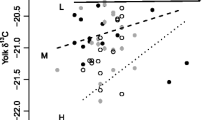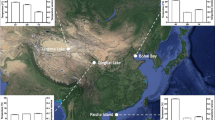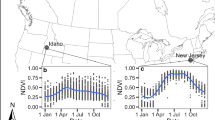Abstract
The strategy of relying extensively on stored resources for reproduction has been termed capital breeding and is in contrast to income breeding, where needs of reproduction are satisfied by exogenous (dietary) resources. Most species likely fall somewhere between these two extremes, and the position of an organism along this gradient can influence several key life-history traits. Common eiders (Somateria mollissima) are the only flying birds that are still typically considered pure capital breeders, suggesting that they depend exclusively on endogenous reserves to form their eggs and incubate. We investigated the annual and seasonal variation in contributions of endogenous and exogenous resources to egg formation in eiders breeding at the East Bay colony in the Canadian Arctic. We collected prey items along with females and their eggs during various stages of breeding and used two complementary analytical approaches: body reserve dynamics and stable isotope [δ13C, δ15N] mixing models. Indices of protein reserves remained stable from pre-laying to post-laying stages, while lipid reserves declined significantly during laying. Similarly, stable isotope analyses indicated that (1) exogenous nutrients derived from marine invertebrates strongly contributed to the formation of lipid-free egg constituents, and (2) yolk lipids were constituted mostly from endogenous lipids. We also found evidence of seasonal variation in the use of body reserves, with early breeders using proportionally more exogenous proteins to form each egg than late breeders. Based on these results, we reject the hypothesis that eiders are pure capital layers. In these flying birds, the fitness costs of a strict capital breeding strategy, such as temporary loss of flight capability and limitation of clutch and egg size, may outweigh benefits such as a reduction in egg predation rate.





Similar content being viewed by others
References
Abraham KF, Ankney CD (1986) Summer birds of East Bay, Southampton Island, Northwest Territories. Canadian Field-Nat 100:180–185
Andersson M, Waldeck P (2006) Reproductive tactics under severe egg predation: an eider’s dilemma. Oecologia 148:350–355
Barnes C, Jennings S, Polunin NVC, Lancaster JE (2008) The importance of quantifying inherent variability when interpreting stable isotope field data. Oecologia 155:227–235
Bêty J, Gauthier G, Korpimäki E, Giroux JF (2002) Shared predators and indirect trophic interactions: lemming cycle and arctic-nesting geese. J Anim Ecol 71:88–98
Bêty J, Gauthier G, Giroux JF (2003) Body condition, migration, and timing of reproduction in snow geese: a test of the condition-dependent model of optimal clutch size. Am Nat 162:110–121
Bond JC, Esler D, Hobson KA (2007) Isotopic evidence for sources of nutrients allocated to clutch formation by harlequin ducks. Condor 109:698–704
Bottitta GE, Nol E, Gilchrist HG (2003) Effects of experimental manipulation of incubation length on behavior and body mass of common eiders in the Canadian Arctic. Waterbirds 26:100–107
Brown GP, Shine R (2002) Reproductive ecology of a tropical natricine snake, Tropidonophis mairii (Colubridae). J Zool 258:63–72
Carabel S, Godinez-Dominguez E, Verisimo P, Fernandez L, Freire J (2006) An assessment of sample processing methods for stable isotope analyses of marine food webs. J Exp Mar Biol Ecol 336:254–261
Casas J, Pincebourde S, Mandon N, Vannier F, Poujol R, Giron D (2005) Lifetime nutrient dynamics reveal simultaneous capital and income breeding in a parasitoid. Ecology 86:545–554
Chastel O, Weimerskirch H, Jouventin P (1995) Body condition and seabird reproductive performance: a study of three petrel species. Ecology 76:2240–2246
Chaulk KG, Robertson GJ, Montevecchi WA (2007) Landscape features and sea ice influence nesting common eider abundance and dispersion. Can J Zool 85:301–309
Christensen TK (2000) Female pre-nesting foraging and male vigilance in common eider Somateria mollissima. Bird Study 47:311–319
Drent RH, Daan S (1980) The prudent parent: energetic adjustments in avian breeding. Ardea 68:225–252
Festa-Bianchet M, Gaillard JM, Jorgenson JT (1998) Mass- and density-dependent reproductive success and reproductive costs in a capital breeder. Am Nat 152:367–379
Gaston AJ, Gilchrist HG, Hipfner JM (2005) Climate change ice conditions and reproduction in an Arctic nesting marine bird: Brunnich’s guillemot (Uria lomvia L.). J Anim Ecol 74:832–841
Gauthier G, Bety J, Hobson KA (2003) Are greater snow geese capital breeders? New evidence from a stable-isotope model. Ecology 84:3250–3264
Gorman KB, Esler D, Flint PL, Williams TD (2008) Nutrient-reserve dynamics during egg production by female greater scaup (Aythya marila): relationships with timing of reproduction. Auk 125:384–394
Guillemette M (2001) Foraging before spring migration and before breeding in common eiders: Does hyperphagia occur? Condor 103:633–638
Guillemette M, Ouellet JF (2005a) Temporary flightlessness as a potential cost of reproduction in pre-laying common eiders Somateria mollissima. Ibis 147:301–306
Guillemette M, Ouellet JF (2005b) Temporary flightlessness in pre-laying common eiders Somateria mollissima: are females constrained by excessive wing-loading or by minimal flight muscle ratio? Ibis 147:293–300
Hanssen SA, Engebretsen H, Erikstad KE (2002) Incubation start and egg size in relation to body reserves in the common eider. Behav Ecol Sociobiol 52:282–288
Hario M, Hollmén TE (2004) The role of male mate-guarding in pre-laying common eiders Somateria m. mollissima in the northern Baltic Sea. Ornis Fennica 81:119–127
Hobson KA (1995) Reconstructing avian diets using stable-carbon and nitrogen isotope analysis of egg components––patterns of isotopic fractionation and turnover. Condor 97:752–762
Hobson KA (2006) Using stable isotopes to quantitatively track endogenous and exogenous nutrient allocations to eggs of birds that travel to breed. Ardea 94:359–369
Hobson KA, Clark RG (1992) Assessing avian diets using stable isotopes.1. Turnover of C-13 in tissues. Condor 94:181–188
Hobson KA, Atwell L, Wassenaar LI, Yerkes T (2004) Estimating endogenous nutrient allocations to reproduction in redhead ducks: a dual isotope approach using delta D and delta C-13 measurements of female and egg tissues. Funct Ecol 18:737–745
Hobson KA, Thompson JE, Evans MR, Boyd S (2005) Tracing nutrient allocation to reproduction in Barrow’s goldeneye. J Wildl Manag 69:1221–1228
Inger R, Bearhop S (2008) Applications of stable isotope analyses to avian ecology. Ibis 150:447–461
Jackson AL, Inger R, Bearhop S, Parnell A (2009) Erroneous behaviour of MixSIR, a recently published Bayesian isotope mixing model: a discussion of Moore & Semmens (2008). Ecol Lett 12:E1–E5
Jamieson SE (2003) Endogenous reserve dynamics of northern common eiders (Somateria mollissiam borealis) wintering in Greenland. Masters thesis, University of New Brunswick, Canada
Jamieson SE, Gilchrist HG, Merkel FR, Falk K, Diamond AW (2006) An evaluation of methods used to estimate carcass composition of common eiders Somateria mollissima. Wildl Biol 12:219–226
Jardine TD, Chernoff E, Curry RA (2008) Maternal transfer of carbon and nitrogen to progeny of sea-run and resident brook trout (Salvelinus fontinalis). Can J Fish Aquat Sci 65:2201–2210
Jönsson KI (1997) Capital and income breeding as alternative tactics of resource use in reproduction. Oikos 78:57–66
Klaassen M, Abraham KF, Jefferies RL, Vrtiska M (2006) Factors affecting the site of investment, and the reliance on savings for arctic breeders: the capital-income dichotomy revisited. Ardea 94:371–384
Lepage D, Gauthier G, Menu S (2000) Reproductive consequences of egg-laying decisions in snow geese. J Anim Ecol 69:414–427
Lewis RJ, Kappeler PM (2005) Are Kirindy Sifaka capital or income breeders? It depends. Am J Primatol 67:365–369
Love OP, Gilchrist HG, Descamps S, Semeniuk CAD, Bêty J (2010) Pre-laying climatic cues can time reproduction to optimally match offspring hatching and ice conditions in an Arctic marine bird. Oecologia 164:277–286
Meijer T, Drent R (1999) Re-examination of the capital and income dichotomy in breeding birds. Ibis 141:399–414
Moore JW, Semmens BX (2008) Incorporating uncertainty and prior information into stable isotope mixing models. Ecol Lett 11:470–480
Mosbech A, Gilchrist G, Merkel F, Sonne C, Flagstad A, Nyegaard H (2006) Year-round movements of Northern common eiders Somateria mollissima borealis breeding in Arctic Canada and West Greenland followed by satellite telemetry. Ardea 94:651–665
Ouellet J-F, Guillemette M, Blier PU (2008) Morphological and physiological aspects of takeoff aptitudes of female common eiders (Somateria mollissima) during the pre-laying period. Can J Zool 86:462–469
Parker H, Holm H (1990) Patterns of nutrient and energy-expenditure in female common eiders nesting in the high Arctic. Auk 107:660–668
Phillips DL (2001) Mixing models in analyses of diet using multiple stable isotopes: a critique. Oecologia 127:166–170
Phillips DL, Gregg JW (2003) Source partitioning using stable isotopes: coping with too many sources. Oecologia 136:261–269
Robertson GJ (1995) Factors affecting nest-site selection and nesting success in the common eider Somateria-Mollissima. Ibis 137:109–115
Rowe L, Ludwig D, Schluter D (1994) Time, condition, and the seasonal decline of avian clutch size. Am Nat 143:698–772
Sedinger JS, Ankney CD, Alisauskas RT (1997) Refined methods for assessment of nutrient reserve use and regulation of clutch size. Condor 99:836–840
Semmens BX, Moore JW, Ward EJ (2009) Improving Bayesian isotope mixing models: a response to Jackson et al. (2009). Ecol Lett 12:E6–E8
Sénéchal E, Bêty J, Gilchrist GH (2011) Interactions between lay date, clutch size and post-laying energetic needs in a capital breeder. Behav Ecol (in press)
Socha R, Sula J (2008) Differential allocation of protein resources to flight muscles and reproductive organs in the flightless wing-polymorphic bug, Pyrrhocoris apterus (L.) (Heteroptera). J Comp Physiol B 178:179–188
Soreide JE, Tamelander T, Hop H, Hobson KA, Johansen I (2006) Sample preparation effects on stable C and N isotope values: a comparison of methods in Arctic marine food web studies. Mar Ecol Prog Ser 328:17–28
Stearns SC (1992) The evolution of life histories. Oxford University Press, Oxford
Stephens PA, Boyd IL, McNamara JM, Houston AI (2009) Capital breeding and income breeding: their meaning, measurement, and worth. Ecology 90:2057–2067
Stevens L (2000) Lipids and their metabolism. In: Avian biochemistry and molecular biology. Cambridge University Press, London, pp 54–60
Swennen C, Ursem JCH, Duiven P (1993) Determinate laying and egg attendance in common eiders. Ornis Scandinavica 24:48–52
Varpe O, Jorgensen C, Tarling GA, Fiksen O (2009) The adaptive value of energy storage and capital breeding in seasonal environments. Oikos 118:363–370
Watson MD, Robertson GJ, Cooke F (1993) Egg-laying time and laying interval in the common eider. Condor 95:869–878
Williams TD (1999) Avian reproduction, overview. In: Encyclopedia of reproduction, vol 1. Academic Press, Toronto, pp 325–336
Wolf N, Carleton SA, Martinez del Rio C (2009) Ten years of experimental animal isotopic ecology. Funct Ecol 23:17–26
Zera AJ, Potts J, Kobus K (1998) The physiology of life-history trade-offs: experimental analysis of a hormonally induced life-history trade-off in Gryllus assimilis. Am Nat 152:7–23
Acknowledgments
This study was supported by (alphabetical order): Canadian Wildlife Service (Environment Canada), Fonds Québécois de la Recherche sur la Nature et les Technologies, Natural Sciences and Engineering Research Council of Canada, Network of Centers of Excellence of Canada ArcticNet, Northern Scientific Training Program (Indian and Northern Affairs Canada), Nunavut Wildlife Management Board, Polar Continental Shelf Project (PCSP), and Université du Québec à Rimouski. We also thank the East Bay crews for their valuable work in the field, F. Hartog and O. D’Amours for their diving expertise, and B. Boucher and R. Chabot for their help in marine invertebrate identification. B.X. Mora-Alvarez assisted with preparation of stable isotope samples which were analyzed by M. Stocki at the Department of Soil Science, University of Saskatchewan. M. Fast provided useful comments on the final version of the manuscript. The Canadian Council on Animal Care has approved the study.
Author information
Authors and Affiliations
Corresponding author
Additional information
Communicated by Markku Orell.
Electronic supplementary material
Below is the link to the electronic supplementary material.
Rights and permissions
About this article
Cite this article
Sénéchal, É., Bêty, J., Gilchrist, H.G. et al. Do purely capital layers exist among flying birds? Evidence of exogenous contribution to arctic-nesting common eider eggs. Oecologia 165, 593–604 (2011). https://doi.org/10.1007/s00442-010-1853-4
Received:
Accepted:
Published:
Issue Date:
DOI: https://doi.org/10.1007/s00442-010-1853-4




